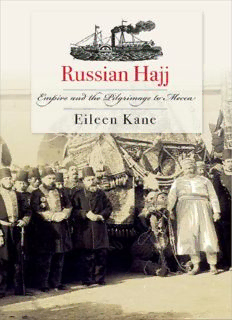
Russian Hajj: Empire and the Pilgrimage to Mecca PDF
Preview Russian Hajj: Empire and the Pilgrimage to Mecca
Russian Hajj Russian Hajj EMPIRE AND THE PILGRIMAGE TO MECCA Eileen Kane Cornell University Press Ithaca and London Cornell University Press gratefully acknowledges receipt of a subvention from the Research Matters program of Connecticut College which assisted in the publication of this book. Copyright © 2015 by Cornell University All rights reserved. Except for brief quotations in a review, this book, or parts thereof, must not be reproduced in any form without permission in writing from the publisher. For information, address Cornell University Press, Sage House, 512 East State Street, Ithaca, New York 14850. First published 2015 by Cornell University Press Printed in the United States of America Library of Congress Cataloging-in-Publication Data Kane, Eileen M., 1972– author. Russian hajj : empire and the pilgrimage to Mecca / Eileen Kane. pages cm Includes bibliographical references and index. ISBN 978-0-8014-5423-3 (cloth : alk. paper) 1. Muslim pilgrims and pilgrimages—Russia—History. 2. Islam and state— Russia—History. 3. Muslim pilgrims and pilgrimages—Saudi Arabia—Mecca— History. I. Title. BP187.3.K266 2015 297.3'52—dc23 2015010887 Cornell University Press strives to use environmentally responsible suppliers and materials to the fullest extent possible in the publishing of its books. Such materials include vegetable-based, low-VOC inks and acid-free papers that are recycled, totally chlorine-free, or partly composed of nonwood fibers. For further information, visit our website at www.cornellpress.cornell.edu. Cloth printing 10 9 8 7 6 5 4 3 2 1 For my mother and father and in memory of my brother Matthew (1978–1998) St. Petersburg BALTIC S SEA MMoossccooww NNiozvhgnoiiroKKdaazzaann L N WWaarrssaaww A Penza SSaammaarraa Orenburg KKuurrsskk R QQIINNGG VViieennnnaa KKiieevv SSaarraattoovv EEMMPPIIRREE KKhhaarrkkoovv BBuuddaappeesstt U RR UU SS SS II AA NN EE MM PP II RR EE BBeellggrraaddee OOddeessssaa AAssttrraakkhhaann BishkekN S H A N SSooffiiaa Sevastopol Feodosiia TIA BLACK SEA TTaasshhkkeenntt AAnnddiijjaann Constantinople Sinop Poti CASPIAN KHIVA Urgench KKaasshhggaarr Batumi CA Tiflis SEA Khiva SSaammaarrkkaanndd Ankara Trabzon UKCarAsSUS Baku KrasnovodskBBuukkhhaarraa Izmir OOTTTTOOMMAANN EEEErrMMzzuuPPrrIIuuRRmmEETTaabbrriizz Enzeli Ashkhabad MervBHUIKNHADRUA KUS H AAlleeppppoo MMoossuull RRaasshhtt Mashhad Kabul PPeesshhaawwaarr MEDITERRANEAN SEA Homs Teheran KushkaAAFFGGHHAANNIISSTTAANN KermanshahPPEERRSSIIAA Herat Beirut DDaammaassccuuss BBaagghhddaadd Port Said Jaffa KKaarrbbaallaa Alexandria JJeerruussaalleemm NNaajjaaff CCaaiirroo SSuueezz BBaassrraa BBRRIITTIISSHH IINNDDIIAA EEll–-TToorr PERSIAN GULF MMeeddiinnaa Yanbu Jeddah Mecca Bombay RED SEA ARABIAN SEA Kamaran Island Hodeidah 0 100200300400 500 mi 0 200 400 600 800 km Border of Russian Empire, c. 1900 Map 1. The Russian Empire and neighboring lands, ca. 1900 contents List of Maps viii Preface: Sources and Maps ix Introduction: Russia as a Crossroads of the Global Hajj 1 1 Imperialism through Islamic Networks 17 2 Mapping the Hajj, Integrating Muslims 47 3 Forging a Russian Hajj Route 86 4 The Hajj and Religious Politics after 1905 120 5 The Hajj and Socialist Revolution 157 Conclusion: Russian Hajj in the Twenty-First Century 183 Acknowledgments 187 Abbreviations 191 Notes 193 Bibliography 219 Index 233 vii maps 1. The Russian Empire and neighboring lands, ca. 1900 vi 2. Main Russian hajj routes, late nineteenth and early twentieth centuries xii–xiii 3. Hajj route followed by caravan from Kazikumukh in the North Caucasus, 1839–1841 32 4. Changing Central Asian hajj routes, 1880s–1910s 71 5. Hajj route through Russian lands followed by Persian subject Farahani, 1885–1886 96 6. Hajj routes through Central Europe followed by Russian subjects Al΄mushev (1899) and Akchura (1911) 155 viii : preface sources and maps T his study was made possible by an accidental discovery in the Russian impe- rial foreign policy archives in Moscow (AVPRI). Looking for material on Rus- sian Orthodox pilgrimage to Jerusalem, I found folders of correspondence about Muslims making the pilgrimage to Mecca, most of them with blank tags, indicating that they had never been read by researchers. AVPRI, I later discovered through a more deliberate search, is a trove of documents on the nineteenth- and early twentieth-century hajj, as understood by Russian con- sular officials posted along routes to Mecca in Ottoman, Persian, and Indian lands. Reading through these sources, I was struck by the confounding image of the Russian Empire they conjured—seemingly disparate regions of the empire were revealed to be closely connected; imperial populations appeared out of place; and Russian officials operated in parts of the world and in ways not captured by standard narratives. Gradually, these sources revealed to me a sys- tem: a cross-border hajj infrastructure that the tsarist state built to support the movement of Muslims between Russian-ruled lands and Arabia. This infra- structure had administrative and political coherence of its own, and it seemed ideally suited to study, given the abundance and accessibility of material. I wrote this book to document a fascinating and virtually unknown chapter of Russian history, and in the hope that a history of Russia told through a focus on human mobility might illuminate how rapid changes sweeping the globe in the late nineteenth and early twentieth centuries shaped Russia’s history in ways that conventional domestic frameworks have so far obscured. One of the ix
Description: